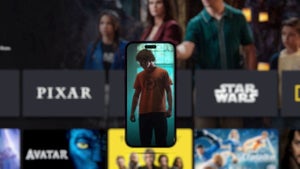Article
Mobilize 2011 Wrap-up
- October 1, 2011
- Updated: July 2, 2025 at 8:56 AM
September 26 and 27 brought Mobilize 2011 presented by GigaOM, to San Francisco where big names in the evolving mobile market came together to talk about the near future of mobile.
Every developer, publisher, and company arrived with ideas of where the mobile market would be heading in 2012 and years beyond. Thoughts about the migration of users to smartphones and the rise of HTML 5 were big topics of discussion.

During many of the sessions I attended, speakers discussed their opinions of the landscape of the mobile environment and how they were experimenting with the influx of new users across Android and iOS.
Here’s a little bit of what I learned during the two day event.
Pandora
Pandora is a well-known brand for streaming internet radio. With the release of their smartphone applications, the company saw a big shift in users moving away from the browser experience. CTO and EVP of Product Tom Conrad had good insight into how the company saw itself in the web and smartphone markets.
Conrad said that Pandora’s goal was to be the future of radio. Since they launched in the summer of 2008 with their iOS app that released with the then-new App Store, Pandora’s 13 million users has grown into 100 million today. The integration of Pandora into cars is another venue that the company has started, bringing another level of integration to a different demographic.

70% of the hours spent listening have been through mobile devices. Both iOS and Android are very important platforms for Pandora to focus on and the company spent a lot of time working and improving the apps. While they were working with on the mobile apps, the company took a look at the aged browser version of the service. Pandora then decided that they should revamp the browser user experience and released a new site built with HTML 5.
Conrad also mentioned the necessity of a unified experience for users across platforms. The importance of the unified experience is that users need to be able to recognize service and having different user interfaces would confuse and deter users.
Since social interaction is a very important part of a user’s online experience now, adding social tools for more interaction with other users was also important. At the same time, Pandora is also working with Facebook to include integration with the new Timeline and Ticker platform.
Pandora, compared to other services, is old; but they are consistently looking to improve their presence on the web and mobile devices while looking towards partners to keep their goal of being the future of radio. Even when asked about Spotify, Conrad said that the service offered something different from Pandora and their co-existence was mutually beneficial.
Square and NFC
I attended two different speaker sessions that were back to back, but referenced each other greatly.
 Square’s COO Keith Rabois talked about the company and how their Square service has become one of the major ways consumers can process their own payments, basically becoming their own store, merchant, and owner rolled into one.
Square’s COO Keith Rabois talked about the company and how their Square service has become one of the major ways consumers can process their own payments, basically becoming their own store, merchant, and owner rolled into one.
The process of using a card reader that can process payments opened the doors for many companies who used to rely just on cash transactions. Rabois called Square “PayPal for the Real World” meaning it allowed people to exchange money for services without relying on cash or check, adding a level of security to the transaction.
Rabois also said that in his opinion, NFC (Near Field Communication) wouldn’t grow to become a new standard for payments. The Square reader was created to process credit cards in the most common way.
Most consumers are used to the idea of having their cards swiped through a reader so there wasn’t a mental disconnect with the reader as an extension of the recognized service. He also wasn’t sure about the viability of Google Wallet yet as it was still in its infancy as a common service.
With the end of the year coming, Rabios also announced that Square would be rolling out two major releases.

On the other side, four members of the mobile and payment industry had a moderated talk about whether 2012 would be the year for mobile payments. The four members of the session were:
- Laura Chambers – Senior Director of PayPal Mobile
Brad Greene – Senior Business Leader Visa
Chris Hylen – VP and GM Payment Solutions Division Intuit
Dave Talach – VP Global Product Management Verifone
Even though a lot of time during the debate was spent pushing their personal company’s plans for new payment technology, there were some overall agreements about the new potential standard of paying with mobile devices.
The focus of the debate was about using Near Field Communication (NFC) technology, most recently released in conjunction with Google Wallet. Each member talked about the difficulties that their companies faced, not with the technology; but the long term adoption of the service as an alternative.
All of the companies saw 2012 as the transition year, where retailers would start to research, accept, and adopt new technologies; but as a mainstream acceptance of mobile payments, specifically NFC might not happen for three to five years.
One of the main issues of the lack of current acceptance was something that Square COO Keith Rabois stated before. Cash and credit payments are easy ways to pay without a lot of work involved and it’s a recognized and familiar system.

Adding the idea of touch-based payments is alien to most people. It’s not an complicated process of touching a smartphone to a small pad, but collecting all forms of communication, identification, and payment into one device may overload the general population.
The panel closed saying that there will be a good growth curve that may start in 2012, but could possibly continue at a higher pace beyond 2012.
Instagram and starting developers
Instagram is one of the standout apps on iOS. When they launched until today, they have accrued some 10 million users around the world, Japan being a major influential market.
The recent release of ver. 2.0 of Instagram was a big discussion about the iteration schedule of apps on the App Store. The new version of Instagram now includes adding hashtags, @mentions, and the ability to upload high definition images.
Instagram CEO Kevin Systrom recalled how the original app began streaming the filtered images even before the user finished their image to increase the user experience. Finding their picture was “uploaded” when they tapped done dramatically increased the satisfaction of the app for users.
Instagram 2.0 took the filter program and rewrote the application processes to optimize the experience. The filters now take 0.4 to 0.5 milliseconds to apply filters. Systrom also talked about the difficulty to work towards big iteration releases, taking a lot of resources to test and complete, and including the Apple approval process.
He said that new developers should “do fewer things more quickly.” Meaning that by having a consistent iteration schedule, bugs and user issues could be correctly at a faster pace as opposed to waiting for the large version changes.
Putting emotion into the product was a big focus for the company because essentially uploading pictures is a personal experience. Systrom saw Instagram as an entertainment platform rather than a photo-editing application.
When talking about the business of Instagram, he discussed the possibility of premium services or virtual goods. The justification that Instagram saw was that with paid services, it would allow the company to experiment more. He commented that users were already selecting to subscribe to advertisers with big name brands utilizing Instagram with product images and launches.
Systrom did hint that other platforms were prepared for the future with the possibility of a web and Android version of the application. He stressed though that the plan was to deliver a strong product on one platform before branching out to new systems.
VP Engineering Michael Abbott came out to talk about how the mobile space affected the spread of Twitter and how people were interacting with the service on mobile.
Abbott noted some metrics like 45% of tweets came from mobile devices and that there were around 230 million tweets per day.

With Twitter and the announced integration with Apple’s iOS 5, Abbott discussed that regardless of integration; the user experience should be consistent and simplified. Whether using the service on iOS, Android, BlackBerry, or browser; the unified experience was important for user retention and satisfaction.
Notifications were the first step in the user experience, leaning towards a more social experience with knowledge that others were interacting with their tweets. Also increasing the engagement on Twitter on mobile devices was an important step.
The integration led Twitter to increase their infrastructure. The possible tsunami of content that could flow with the release of iOS 5 was something Twitter has been preparing for and it was one hope that the “Fail Whale” would stop making its appearance.
Facebook has taken some big steps in increasing their presence across mobile devices. Their acquisition of SnapTu and rebranding it as Facebook for Every Phone for feature phones has brought many more users into the mobile market. While they might not be able to have the same experience as smartphone users, Facebook was smart to work on including this lesser known demographic.
Erick Tseng, Head of Mobile Products, talked about how Facebook was working on making the mobile environment more social.
From the early platform update to the announcement of Timeline and Ticker, Facebook has been “listening” to its users. The new user experience has made many vocal on their opinions and Timeline will change the landscape entirely.
Tseng commented that the Ticker was a new paradigm in user experience. Updating in real-time, it filled a missing gap. He said that if notifications were the beta, Ticker was the real product. The updates to the smartphone mobile apps also included something that most users didn’t even notice: HTML 5.
With the goal for Facebook to be a platform (which is apparent with Timeline), the future of Facebook is heading in a direction most people might not expect.
High Engagement Apps
It appears that developers and publishers are moving away from the idea of using download numbers as the metric to success. As apps can have huge download numbers, there is also the possibility that most of those users leave the app after their first experience. There were four experts in the panel:
- Danilo Campos – Mobile Dude Hipmunk
Steve Douty – VP Applications and Mobile Product Management Yahoo!
Tom Want – Head of Product Formspring
Neil Young – CEO ngmoco
There were three metrics that developers and publisher now used to gauge how their application was doing.
- measurement return rate: how often users played the app again
number of sessions per day: how many times the app was played
minutes per session: how long the app was played
These new metrics illustrated how engaging their application was. It was agreed that apps that had a precise and simple focus did the best. While it sounded good to give an immense amount of tools and usability, most users found a giant amount of options oppressive. Also the personalization of applications brought more users to the app.
It sounds like the general ideas are something that really popular developers have been subscribing to in their apps. But with the massive amount of applications in different genres, it does make it difficult to stick out without adding either a known brand or some form of individual.
Though users are more willing to try new apps through the use of what the panel called “referrals.” Whether these are word of mouth or social network suggestions, referrals are a big influencer on the adoption of applications.
Mobilize 2011 was a great insight into the upcoming mobile environment. While it might look like developers and publishers aren’t doing much on the surface, chances are they are researching, updating, testing, and preparing for the future.
Even with big companies changing scales from their browser services to mobile devices, the apparent acceptance in development with HTML 5 is going to have a big effect on the mobile landscape. Mobile payments might not see widespread adoption, but companies are working toward many options for paying with a mobile device. NFC is coming on the front of the wave, but it might not be the last or best option for consumers.
Users should benefit from the rapid evolution, though it might be up to the hardware makers to release phones that fully support the newest changes. Smartphones are now the standard market share and faster cellular networks are going to open more boundaries in the future.
You may also like
 Article
ArticleA Greener Web and Cleaner Oceans: Why So Many Are Switching to Wave Browser
Read more
 News
NewsThe Worst of CES: AI takes the worst of these devices, according to experts
Read more
 News
NewsGerard Butler has just released the sequel to his 2020 action movie
Read more
 News
NewsDonald Trump has given the green light to cybercriminals (and you probably haven't noticed)
Read more
 News
NewsDisney+ is already experimenting with vertical video, and it's not the only one
Read more
 News
NewsNeither a remake nor a reboot: the new 'Buffy the Vampire Slayer' is a continuation of the original
Read more